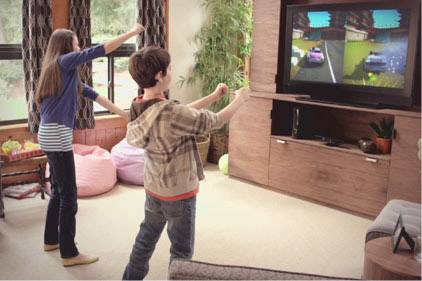- Qualcomm Launches Snapdragon 4 Gen 2 Mobile Platform
- AMD Launches Ryzen PRO 7000 Series Mobile & Desktop Platform
- Intel Launches Sleek Single-Slot Arc Pro A60 Workstation Graphics Card
- NVIDIA Announces Latest Ada Lovelace Additions: GeForce RTX 4060 Ti & RTX 4060
- Maxon Redshift With AMD Radeon GPU Rendering Support Now Available
Kinecting the Dots: Where Motion Gaming Needs to Change

With the three major console developers having launched their respective motion technologies, the hungry demand for games that get people out of their chairs is being fed. But does that mean that current implementations are perfect? I don’t think so, and attempt to explain the reasons why.
When Nintendo launched the Wii in late 2006, it brought something to the table that neither Microsoft’s Xbox 360 or Sony’s PlayStation 3 did – motion gaming. There are peripherals, and then there are innovative peripherals. The Wii’s Wiimote is certainly of the latter category.
While a peripheral like a steering wheel is at its core a gamepad with a different frame, the Wiimote allowed gamers to use their bodies to control the game, and despite still requiring a controller, it’s a gaming aspect that both Microsoft and Sony at the time seemed to have severely underestimated.
The time leading up to the Wii’s launch was one filled with hype, and admittedly, even I got excited for it. Even though I thought motion gaming was a little pointless at first, I decided to open my mind and picked up a console at launch, along with a pile of games. Not too long afterward, I wrote an article chronicling what I thought were the Wii’s top five downfalls, and to those, some agreed with me, and some didn’t.

Microsoft’s Kinect
As odd as it might have sounded, I found the Wii’s main selling-point to be one of its biggest downfalls. For some things, I liked the fact that I could use the Wiimote to control things on the screen, but after a while, I found it to become tedious, and no longer fun. The Legend of Zelda: Twilight Princess, for example, is a game that shouldn’t have used motion at all, because for all intents and purposes, it’s a full-board adventure game. All of the parts that did utilize motion, didn’t need it. The fact that there was a GameCube version of the same game proved that.
At the same time, I quite enjoyed Tony Hawk’s Downhill Jam, a skateboarding game that acted more like a racer. Here, the motion worked almost perfectly, as for the most part, it merely required you to move your hand left and right, and on occasion upwards, along with the pressing of some buttons. At around this time, I had figured that for some games, motion was perfect, and for others, not so much.
A couple of months after the Wii launched, I began to notice something. Months passed, and I didn’t even turn on the console once. Then, almost an entire year passed, and I finally hooked it back up to play Super Mario Galaxy (great game, for the record). Once that game was done with, I shelved the console again, and to date haven’t touched it again. That’s right. I haven’t as much as turned on the Wii in about three years. What’s wrong with me?
Lots, I’m sure, but in this case, the allure of motion gaming wore off quick, and given that was the console’s major focus, I just lost interest in it as a whole. The games I did play felt dumbed-down, and as more of a “hardcore” gamer, I stuck mostly to the PC and played with the PS3 and Xbox 360 when I wanted some console action. A couple of months ago, however, my interest in motion gaming was surprisingly rekindled with the PlayStation’s Move and Xbox 360’s Kinect. At first I couldn’t figure out why.

The Legend of Zelda: Twilight Princess
Could it possibly be that the Wii simply didn’t offer compelling enough games to keep me interested? Could I actually still be interested in using motion to play games? Would Move and Kinect change my mind? After seeing the launches for both, I can confidently say that the answer is, “No.” Hold the hate, and hear me out.
The problem I have with the current state of motion gaming is that there seems to be no truly compelling reason to invest time and money into it. I understand that the Wii has sold in the bajillions and that the PlayStation Move has moved over a million units – and counting, but I still fail to see anything captivating about any of it. I see major potential, mind you, but we’re just not quite there.
I’m the first to admit that the motion technologies all three consoles offer is amazing, with major props to Microsoft for kicking things up a notch, but after watching video reviews around the Web, and following the state of the technology with both recent launches, I feel so… underwhelmed.
A problem I saw with the Wii resurfaced with both the Move and Kinect, and that was that the launch titles are in all extents “simple”, and aren’t too compelling. There’s also the issue that while the control is fairly accurate, it’s still nowhere close to the precision of a gamepad. Fortunately, almost all of the complaints I have can be summed up with the help of Kotaku’s review of Joy Ride, a once free but now $50 racing game from Microsoft.

Microsoft’s Kinect Joy Ride
In the video, it’s clear that the reviewer’s movements are not exactly spot on with the action on the screen, which I admit, is to be expected. But should it be accepted? If a gaming mouse had 500ms latency rather than 10ms or less, we wouldn’t put up with it for long. But that’s just about the latency that I can see from the video. It’s still good, but not perfect.
The next problem is the ridiculous movement required to do something on the screen. Patting a cat is one thing, but having to thrust your arms forward to ignite a speed boost seems a little… needless. That kind of motion isn’t something most people would ever do outside of a game, so what makes it fun doing it inside of one? Performing a flip is even worse. It requires you bend backward and then thrust your upper-body forward. My back is sore just picturing this one.
The last major problem can again be exhibited with Joy Ride. Because there are no real controls, the game handles some of the game’s important functions, such as braking and the acceleration. Oh, and backing up? Just not possible. That’s right, in a racing game, braking, accelerating and backing up is outside of your control. Am I the only one who finds that a little strange?
All of these gripes are not major, but they do highlight a problem I’ve had with these “motion” games… the lack of depth. It seems to me that where motion excels is with the simplest of games, and that’s all I can see it excelling at for a while. If we can’t even back our car up in a racing game, or brake for that matter, doesn’t it seem like we’re really going overboard on sacrificing gameplay?

Could you play a game like Final Fantasy with nothing but motion?
Imagine playing a game like Final Fantasy with nothing but motion. Or Call of Duty, Tomb Raider, Rock Band, Halo, Need for Speed and so on. You can’t, because the games require too much input. That doesn’t mean that motion gaming is useless, of course, it just means that until a more impressive solution is created, it seems all games that use nothing but motion are bound to remain simple.
Again, that’s not so much of a problem, but I don’t see people enjoying games like these for long. At the end of the day, I’d like to think that people expect a bit more from their gaming, and severely dumbing it down just so you can flail your arms in the air doesn’t seem like a good enough trade-off.
To an extent I know I’m not alone. I avoided my Wii for quite a while due to disinterest, and while friends of mine haven’t been so unfair to their modest white console, many of them who bought their consoles at launch hardly touch them at all today. Months go by, and while it remains hooked up, there just doesn’t seem to be a compelling enough reason to want to stand up and move around to do something that could be done with a couple of button pushes on a gamepad.
This has nothing to do with exercise, but quite frankly I think that’s a great use for motion gaming. But most people don’t use the Wii, Move or Kinect for exercise… they use them to play compelling games, and thrusting your arms forward to do what an “A” button could just as easy do on a gamepad, it makes me wonder what the point of it all is? Motion gaming today in no way makes a game more impressive, and if anything, I believe it makes games less so.

The Powerglove… it’s so bad!
I’m not sure what would need to be done to have motion gaming appeal to me, but I’m certain that it can’t be something like the Kinect solution. No gamepad at all is tough, and really rids the chance for deep, timely gameplay. At the same time, people don’t like holding a gamepad while jumping around, either. Perhaps we need a Power Glove follow-up? It sounds crazy, but think about it. If you could move all around and have precise control on the fly, what would be so unappealing?
3D glasses might be another solution, though no implementation I’ve ever seen of those up to this point has been impressive. I might not have the answer, but I do hope to see motion gaming as we know it change in the future, because I think potential is there. That’s just all it is at this point… potential.
Discuss this article in our forums!
Have a comment you wish to make on this article? Recommendations? Criticism? Feel free to head over to our related thread and put your words to our virtual paper! There is no requirement to register in order to respond to these threads, but it sure doesn’t hurt!
Support our efforts! With ad revenue at an all-time low for written websites, we're relying more than ever on reader support to help us continue putting so much effort into this type of content. You can support us by becoming a Patron, or by using our Amazon shopping affiliate links listed through our articles. Thanks for your support!





